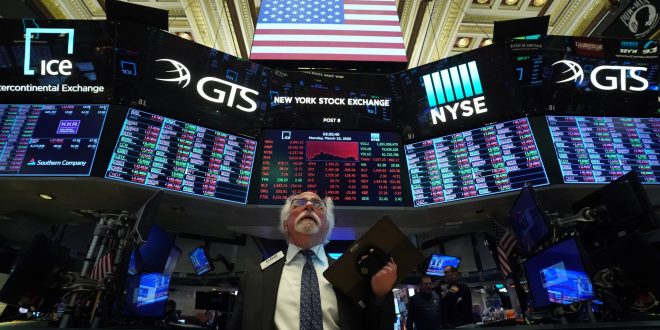The Federal Reserve committed hundreds of billions of dollars to steadying the financial markets. The S&P 500 plummeted nearly 12 percent anyway.
Financial markets imploded again on Monday, as increasingly alarmed investors feared that the global economy could experience a downturn rivaling the cataclysmic recession after the financial crisis a decade ago.
Even President Trump’s boundless enthusiasm for the American economy has wilted in the face of what promises to be a widespread economic slowdown, as he acknowledged on Monday that the country might be heading toward a recession.
The air of inevitable decline was palpable. A day after the Federal Reserve unleashed a major effort to shore up market confidence, the S&P 500 plunged nearly 12 percent on Monday — the latest in a series of big drops since the pandemic knocked it from a record high and the worst one-day decline since 1987.
There are few historical parallels for the shock waves created by the coronavirus pandemic. From still-closed factories in China — where the outbreak first emerged — to Western nations where millions of people are living in a state of semi-house arrest, most of the engines that keep the global economy aloft have simultaneously sputtered to a halt.
Some of the first snapshots to capture the gravity of the outbreak’s effect on economic activity appeared on Monday, suggesting that industrial activity has fallen off both in parts of the United States and in China.
Factory activity in China, the world’s second-largest economy, dropped 13.5 percent last month from February 2019. Fixed-asset investment, which touches on construction of buildings, roads and railways and was long the driver of Chinese growth, fell roughly 25 percent.
And one of the first bits of data for American economic activity in March, a gauge of manufacturing activity in New York State, showed the worst one-month plunge in the index’s history, falling to its lowest level since 2009.
“Unfortunately this is the new reality,” economic analysts with the investment bank Jefferies wrote. “This report is a harbinger of what is to come.”
The forecasts for growth that economists were making just a few weeks ago have been erased, replaced by penciled-in predictions of a sharp contraction. Goldman Sachs analysts now expect gross domestic product in the United States to contract at a 5 percent annual rate in the second quarter of 2020, in what would be the steepest drop since late 2008. JPMorgan Chase economists recently wrote that “the coming collapse in consumer spending will pull first-half growth into negative territory.”
But the continuing collapse in financial markets suggests that investors think the reality could be beyond the powers of central banks such as the Fed to stop.
On Sunday, the Fed cut interest rates to near zero and pledged to buy hundreds of billions of dollars’ worth of government bonds and mortgage-backed securities with freshly created money. For the last decade, variations of such programs, known as quantitative easing, have set off huge rallies in stock markets and other risky assets, as investors saw those efforts as a green light to take bigger risks.
Not any more. On Wall Street, stocks plummeted 7 percent after the start of trading, triggering a 15-minute trading halt. It was the third such halt over the last week. The sell-off continued after trading recommenced, undoing the 9.3 percent surge in the S&P 500 on Friday, when a White House news conference promised greater efforts to increase testing for the virus.
“The Fed has a lot of tools in its tool kit. A vaccine isn’t one of them,” said Rick Rieder, chief investment officer of global fixed income at BlackRock. “And I think the markets are realizing that it’s going to be uncertain for a period of time.”
The disorder in financial markets has spread well beyond the market for stocks.
Prices for corporate bonds, both from stable borrowers and riskier companies that issue junk-rated debt, fell. In the options market, the Chicago Board Options Exchange Volatility index, widely considered the stock market’s “fear gauge,” climbed more than 40 percent to its highest level since the worst of the financial crisis.
Prices of commodities have collapsed as the slump in global demand from China has resulted in an oil price war between Saudi Arabia and Russia, two giant global producers of crude. Benchmark prices for American crude oil fell more than 9 percent, to less than $30 a barrel, and gas prices nose-dived. Some analysts predict that oil prices could drop below $20 a barrel in the coming weeks.
In the past, collapsing oil, natural gas and gasoline prices were a boon to the economy, helping consumers and lowering the trade deficit. But things have changed over the last decade. A fracking and drilling boom has converted the United States from big importer to a large exporter of petroleum and petroleum byproducts.
That means several economically important states, including Texas, are poised to be hurt. Tens of thousands of jobs are at stake, and many regional banks have lent heavily to small oil companies that could face bankruptcy if prices stay low.
Regional banks were some of the hardest-hit shares on Monday. The S&P 500 financial sector fell nearly 14 percent, with regional lenders such as Fifth Third, Citizens Financial and KeyCorp all dropping nearly 22 percent.
Share prices fell sharply for businesses that rely on discretionary spending by consumers. The chain restaurant company Darden fell nearly 25 percent, the retailer L Brands nearly 28 percent and Gap nearly 23 percent.
Perhaps more worrying were the signs of continuing problems in the less visible markets that act as the plumbing of the financial system.
On Monday afternoon, the central bank gave an extra $500 billion injection of short-term loans into the so-called repo market, where banks and other financial institutions get temporary funding. That second round helped to calm the market. But conditions elsewhere remain tight, especially in the market for commercial paper — a form of short-term borrowing that companies use to manage their cash flows and finance their operations.
Investors and bank analysts have started calling for the Fed to buy the short-term corporate debt in order to get the commercial paper market working — something it did during the 2008 financial crisis.
To do so, the Fed would need to declare that the economy faced “unusual and exigent” circumstances, allowing it to use its special lending abilities. It would also require the approval of the Treasury Department.
“It is just really complicated to set these things up,” said Karen Dynan, a former Treasury Department chief economist who worked at the Fed during the 2008 crisis.
And the Fed, she noted, encountered major political backlash for its emergency lending and bailouts during that era.
“They probably feel like they need to be super careful to get things right,” she said.
The New York Times
By Michelle Roberts
 Lebanese Ministry of Information
Lebanese Ministry of Information



